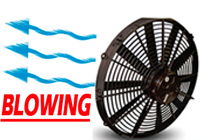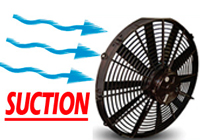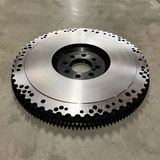Car Cooling Fan - Information

Information about cooling fans for cars. Original or aftermarket? Pulling or pushing? These are just a few questions you will find answers to.
The information is divided into the following sections:
- What Does a Cooling Fan Do
- Different Types of Fans
- Choosing a Fan
- Pushing or Pulling?
- Installing a Cooling Fan
- Accessories
- Problems
- Compare Cooling Fans
1 ▼
What Does a Cooling Fan Do
A cooling fan is used to cool the coolant or oil that passes through the water cooler and oil cooler.A fan is mounted to ensure that the radiator can cool the water/oil in time before it returns to the engine or transmission. By installing a pulling or pushing fan, air is drawn through the radiator's cells to cool the water or oil when the airflow is insufficient. When the car is stationary, there is no airflow to cool, so a fan must assist. Even when the car is running very hot, such as during a race, a fan can help in addition to the natural airflow.
2 ▼
Different Types of Fans
Pushing Cooling FanPushes (blows) air forward through the radiator using the blades and is mounted in front of the radiator.
Pulling Cooling Fan
Draws air through the radiator using the blades and is therefore mounted behind the radiator, between the engine and the radiator.
3 ▼
Choosing a Fan
Determining which cooling fan is suitable for your application is not an easy task; there are many parameters to consider. Therefore, install the largest cooling fan that fits. If you have an original engine, the best choice may be to purchase an OEM fan, but if you have a tuned/modified build, an aftermarket cooling fan may be the best option. Examples of things to consider:- Depending on space or other parameters, a pulling or pushing fan?
- The size of the radiator determines what diameter/size you can use for your specific radiator.
- A larger fan cools more than a smaller one.
- A larger fan that cools more typically draws more current.
4 ▼
Pushing or Pulling?
If you're unsure whether you have a pulling or pushing cooling fan, it’s easy to test by supplying power and observing which direction the air blows. If you have already installed the fan and still feel uncertain, you can hold a piece of paper in front of the radiator/in front of the car to see which direction it blows.
Below is an illustration showing what type of fan you have.


5 ▼
Installing a Cooling Fan
Mounting
The cooling fan is mounted using a fan shroud or mounting clips directly against the radiator. A fan shroud is preferred as it allows the fan to push or pull air through the entire area of the radiator. If the fan is mounted directly to the radiator, the cooling surface will be limited to the size of the fan.
Cabling
Keep in mind that the wiring for a cooling fan is often thicker than that for other electronic products. A powerful cooling fan draws at least 30 Amperes and peaks even higher at startup. Therefore, make sure to use sufficiently thick power cable and ensure proper securing.
Fan Control
A cooling fan can be installed via a manual switch or be temperature-controlled through a coolant temperature sensor. Both use a relay for control.
If you have a switch for manual operation of your cooling fan, be aware that it can easily be forgotten, and the temperature can rise drastically under heavy load, leading to engine damage—this is not recommended.
With the help of a coolant temperature sensor and a control system, you can set the exact temperature at which the fan should start.
Temperature
If the fan or fan motor is located near the turbocharger or exhaust manifold, the lifespan of the fan can be drastically reduced. Make sure to protect against direct radiated heat using metal shielding or other heat protection.
Ensure that no loose objects can reach the cooling fan; use a fan shroud / fan guard!
6 ▼
Accessories
Mounting Brackets for Cooling Fan
Fan Shroud
PWM Control
Connectors
Fan Control / Relay
Coolant Temperature Sensor
7 ▼
Problems
A defective cooling fan can cause major problems for an engine's temperature control and lead to overheating, which can result in engine failure.
The Cooling Fan Does Not Start
- Temperature-controlled cooling fan must reach operating temperature to start.
- Check that the relay/fuses are intact.
- Inspect the wiring for any damage.
- Is the temperature sensor functioning?
- If the fan still does not work, it is most likely defective.
The Cooling Fan Sounds Odd
- Check if all fan blades are intact.
- Check if the fan blades are scraping against anything.
▼
▼
-
Engine management / Electric
- Engine control system: The various parts available
- Ignition System Information
- Install motor control
- Pressure sensor - Information
- Temperature sensor - Information
- Buttons - Switches - Information
- Connectors - Information
- Cooling fan car - Information
- Exhaust gas temperature sensor - EGT Sensor
- Lambda sensor - Wide band lambda
- Relay - Information
- Relay box - Fuse central
- CAN protocol - Canbus
- Ethanol sensor - Information
- Gauges and Dash
- Trigger sensor information
- Dimensioning of cable [and fuse size]
- Distributor Problems (And Solution)
- How does an Ignition Coil work?











































